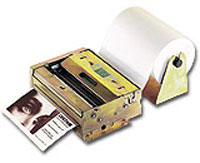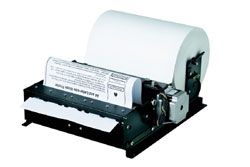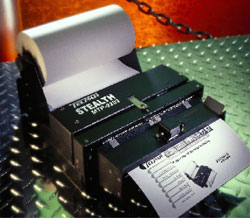Article
Printers ready for primetime
Customers may not think about the printers they put with their kiosks, but they should. If the printer is down, the whole self-service experience could be a bust.
October 13, 2004
"These things need to be bulletproof," said Dana Gosney, chief operating officer of Mercury Online Solutions, about printers he uses in kiosk deployments.
"Printers are mechanical devices, they have a lot of moving parts. So you'd better make sure those parts are good," Gosney added. Mercury uses thermal printers from Swecoin in two separate deployments: 800 kiosks for AT&T Wireless, and about 25 for couponing kiosks in the UK.
While many customers may not think about the printers they put with their kiosks, they should. Because if the printer is down, the whole self-service experience could be a bust. That's why kiosk printers have evolved into fast, reliable machines that can run well in an unmanned environment.
Some key vendors in the kiosk printing market are Custom Engineering, Epson America, HECON, Practical Automation, Swecoin and Telpar. Each uses technology that prevents downtime, from large paper rolls and software drivers that proactively alert users to problems, to heavy-duty cutters that prevent paper jams.
To hear about a milestone such as Northwest Airlines printing its 30 millionth boarding pass, potential customers realize that kiosk printers are ready for primetime.
"There was a perception in the past that printers weren't reliable," said Brian Sikorski, sales and marketing manager of Practical Automation, which supplies the printers to Northwest Airlines. "But improvements have been made. They've been completely reengineered." Practical, for instance, has been providing printing mechanisms to ATMs and other specialty systems for more than 25 years. The company has 20,000 printers deployed around the world.
Sikorski said successful kiosks are units that have been carefully designed, with peripheral manufacturers involved from the early stages.
 |
Custom's simple design |
Not the printers of old
Luca Gaglio, export manager of Custom Engineering, said kiosk printers have undergone many changes over the years. He cites printer speeds, larger roll capacity and smaller footprints as some of the notable changes.
"There is also a big issue of having flexibility in the printer so that the paper roll can be mounted in different positions relative to the printer, and at different angles," said Gaglio.
The biggest concern of printer vendors, according to Elaine Bresnick, vice president of sales and marketing at Swecoin, is preventing paper jams and other problems that require human intervention at all costs.
Bresnick explained that kiosk printers have special challenges because there is always something moving through the mechanism.
"We use components that last many years and through millions of printouts," she said. Bresnick pointed out that unexpected service visits are "extraordinarily" expensive for customers.
She said kiosk printers should have a simple design. "You don't want to over-engineer a self-service product."
D. Shridhar, OEM regional sales manager of Telpar, said he believes kiosk integrators have become more educated about how printers work and are better at designing printers into units. That means they are allowing for proper ventilation, dust-free environments, and using proper software drivers.
Still, he said, the end user often takes printers for granted -- until there is a problem. Bresnick concurred, saying, "People think they can throw any desktop laser printer on a kiosk, which is not true."
 |
Swecoin mechanism |
Mercury Online uses Swecoin
Mercury's Gosney said his company uses two different Swecoin models with clients. A large-format printer is used with client AT&T Wireless. The printers give customers hard copies of their transactions. Customers place an order for a phone and wireless service, and the kiosks print out receipts.
A smaller-format printer is used in Mercury kiosks in the UK. These kiosks, which are placed at campus locations, offer students different coupons that they can use at retail outlets. The coupons are bar-coded, so stores can track whether the kiosks are driving sales.
"I don't need real extremely high-quality printouts, because they won't be around for long. But I do need fast response, reliability and extremely low maintenance," said Gosney.
"I can't imagine with a deployment the size of AT&T having to deal with service issues on the printer all the time," he said. Eventually the UK deployment will reach 1,500 locations, as well.
When looking at printers, Gosney realized he wanted paper on large rolls. "I don't want the customers in there too often, having to change paper," he said. "Swecoin printers have a sensor that alerts them to the paper being low."
Mercury can also remotely monitor the kiosks and be proactive with calling its customers to tell them about paper that needs to be changed.
"With all of my vendors, I demand they have service techs readily available. Thankfully I've never had to call the Swecoin techs."
Another plus with Mercury's printer vendor is that it has an international presence, which is important in the UK deployment.
Swecoin is known for its higher costs, Gosney admitted, but he said that didn't matter to Mercury or its customers. "We are willing to pay a premium. I don't want to pay for service nightmares downstream."
That, he said, is what kept Mercury away from consumer-level devices. The printer vendors would not disclose costs because they vary by deployment.
 |
Telpar printer |
State of Oregon uses Telpar
Don Kerzel, director of sales and marketing for Cascade Computer Maintenance, said he had two things in mind when he started looking at printers for a kiosk deployment his company was overseeing for the State of Oregon. One was that Cascade was the installing company and he wanted ease of installment and use. Two was that Cascade had a commitment for supporting the entire kiosks for five years. "We needed something we could rely on," he said.
Plus, some of the 119 kiosks are in remote parts of the state, and require a five-hour drive for servicing. Kerzel said there will be 150 kiosks deployed around Oregon by next spring.
The State of Oregon had already been using employment kiosks for 10 years. Citizens can go to the kiosks placed around the state and look for jobs, apply for unemployment, review their unemployment benefits, or even learn about daycare options for their children.
The deployment originally used laser printers. "Servicing those gave us some good business," laughed Kerzel. The printers had frequent paper jams, and ran out of toner and paper frequently.
Kerzel turned to Telpar. "Their large rolls of paper are easy to install, and the customer is not sacrificing printer quality at all."
Kerzel was also impressed with Telpar's ability to turn the project around quickly. "The state had a deadline of 60 units by June 30. But we didn't even place our order until the first week of June and everything worked fine," he said.
Enclosure vendor Metal Fx designed the kiosks and built the printer right in.
 |
Practical's wide-format printer |
Carten Technologies uses Practical
Kiosk software vendor Carten Technologies has a close relationship with Practical Automation. Carten not only provides remote management software to the printer vendor, the company also uses the printers and suggests them to its kiosk customers.
"The only time we've had failures on our printers is when we drop them," said Mark Carten, director of Carten Technologies.
"We do things to those printers that even the Practical engineers didn't realize could be done," said Carten. He said he has tested most printers in the industry and that only Practical has met his standards -- particularly in the area of mean time between failures.
"We became interested in what Carten was doing with our printers based on the questions they were posing around our remote monitoring hooks," said Sikorski. "Carten has effectively used all of the 22 points of information our engineers have made available."
He added, "The best-in-class printers use intelligence to minimize human intervention and errors that might occur. The Carten Remote Monitoring software can eliminate issues prior to an event happening."
Carten software allows Practical to send out alerts of the state of each printer. Customers can log onto a Web site to see the information. If there is a problem on a printer, the software generates a voice over IP call within 4 seconds to whomever is in charge of the equipment. A confirmation e-mail is sent for backup, Carten explained.
He said, "We need this kind of intelligence to monitor our customers, especially those oversees."





